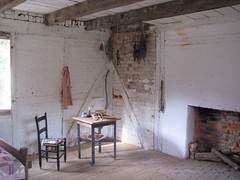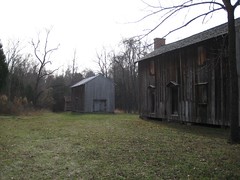The Two Black Classes of Antebellum North Carolina
by Sydney Nathans
Reprinted with permission from the Tar Heel Junior Historian, Fall 1996. Revised by NC Government & Heritage Library, May 2022.
Tar Heel Junior Historian Association, NC Museum of History
See also: James Curry's Childhood in Slavery and James Curry Escapes from Slavery (ANCHOR)
"I was born in Person County, North Carolina. My master’s name was Moses Chambers."
So begins the narrative of James Curry, who was born enslaved in 1815 and escaped to freedom in 1837. He learned how to read and write, he fled slavery successfully, and he told his life story to the world. During the antebellum years, central themes of his story were shared by thousands of enslaved North Carolinians, as well as their free black brethren.
Curry was the child of a distinctive North Carolina heritage of small-scale slavery and a strong free black presence. These two circumstances made the lives of black people in antebellum North Carolina different from the lives of enslaved and free black people elsewhere in the South. First, North Carolina had a smaller number of large plantations than most other southern states. Second, North Carolina had a large number of free black people.
Life as a Slave on a Small Plantation
Curry and his family lived with their enslaver Moses Chambers on a small plantation in the Piedmont. Conditions on a small plantation were sometimes more difficult than those on a larger plantation. For one thing, the chance of abuse by white enslavers was much greater on a small place. In addition, most enslaved people who wanted to marry (enslaved people could not legally marry in North Carolina) had to find their partners "abroad." These spouses then had to work and live apart, rearing their children together only on weekends.
Curry’s mother, Lucy, experienced the hardships of living on a small plantation. She "was the daughter of a white man and a slave woman." At the age of fifteen, Lucy ran away. Only fifteen miles away, she stopped her escape and tried to get word of her whereabouts to her mother. She was hidden for three weeks by a poor white woman but soon recaptured. Lucy later married an enslaved man from abroad and had children, which prevented her from attempting another escape. "Having young children . . . tied her to slavery." Lucy, like many women, could not bring herself to leave her children.
 So she and her husband expected to endure a lifetime of endless, unpaid work. Lucy became the household cook for white and black people alike, the caretaker of her enslaver’s children, and the keeper and milker of fourteen cows. After work, "so tired that she could scarcely stand," she alternated sleep with hours of sewing patches on her family’s clothes. Her husband worked for his enslaver from sunup to sundown and afterward worked on "little patches of ground, raising tobacco and food for hogs." The husband’s enslaver, who provided no clothes or allowance, permitted the husband to sell these products and use the money "earned in the time allowed for sleep" to purchase clothing, coats, and hats for his family.
So she and her husband expected to endure a lifetime of endless, unpaid work. Lucy became the household cook for white and black people alike, the caretaker of her enslaver’s children, and the keeper and milker of fourteen cows. After work, "so tired that she could scarcely stand," she alternated sleep with hours of sewing patches on her family’s clothes. Her husband worked for his enslaver from sunup to sundown and afterward worked on "little patches of ground, raising tobacco and food for hogs." The husband’s enslaver, who provided no clothes or allowance, permitted the husband to sell these products and use the money "earned in the time allowed for sleep" to purchase clothing, coats, and hats for his family.
Lucy’s marriage to her abroad husband was broken when his enslaver decided to move to the cotton country of the Deep South. He was among more than a hundred thousand black North Carolinians forcibly removed from their home state between 1815 and 1860. "The separation of the slaves in this way is little thought of," Curry remarked. "A few masters might regard [a slave] union as sacred, but where one does, a hundred care nothing about it."
After that, Lucy married a free black man named Peter Burnet, Curry’s father. But a white man hired Burnet as a servant for a trip to the southwestern part of the country. Once there, the employer sold him into bondage.
Life as a Free Black
Had Burnet remained in North Carolina from the time of his son’s birth in 1815 until the young man’s escape in 1837, he would have experienced drastic changes in his condition as a free black man.
In 1815 he could testify in court (for or against another black person, but not a white), vote in elections, preach and even organize churches, own and carry a gun, hunt with a dog, and sell food, liquor, or other goods to anyone. But by the mid-1830s, lawmakers had changed the state constitution to take away his right to vote, and county by county, white people enacted regulations called codes to curb many of the other rights of free black men. Many "freedoms" were taken away as a result of Nat Turner’s rebellion in a border county of Virginia in 1831. Fearful white people claimed that the "very existence" of free black people—who hunted with their enslaved brethren, sold goods to or for them, accumulated property, and married enslaved partners—"caused slaves to be disobedient and turbulent."
In the 1840s, white mechanics in Fayetteville, Beaufort, and Raleigh tried to curb competition with free black men who were their equals as skilled workers. However, the state did not adopt the extreme solution the whites proposed: to place a high tax on free black people that would be used to transport them back to Africa.
Restrictions did become so severe, though, that by 1851 a dozen men petitioned for land to be set aside in America’s western territory for a separate colony for free black people. A few years later, another free black North Carolinian became so “tired of being buffeted from place to place with no settled home” that he asked to be re-enslaved.
Hope for Change
For enslaved and free black North Carolinians, the decade of the 1850s was one of growing pressures. Scientific farming improved types of plants and found ways for landowners to renew their soil. In Edgecombe and other eastern counties, for example, where planters began using fertilizers, enslaved people were required to spread as much as 150 pounds of guano per acre. New technologies such as mechanical cotton seeders seemed to promise lightened workloads for slaves. But in reality, an increasing number of those enslaved found themselves pressed to work harder and to produce more, as higher costs (to pay for modernization) led enslavers to demand faster work and larger harvests.
ways for landowners to renew their soil. In Edgecombe and other eastern counties, for example, where planters began using fertilizers, enslaved people were required to spread as much as 150 pounds of guano per acre. New technologies such as mechanical cotton seeders seemed to promise lightened workloads for slaves. But in reality, an increasing number of those enslaved found themselves pressed to work harder and to produce more, as higher costs (to pay for modernization) led enslavers to demand faster work and larger harvests.
Still, the 1850s also became a decade of mounting hopes. Undoubtedly, many enslaved people knew as the 1850s unfolded that momentous events were taking place in the North. They overheard white people trading reports. Some could read newspaper accounts. Many received stories on their own "grapevines." These stories, many about North Carolina exiles, contributed mightily to the swelling freedom movement.
Wilmington’s David Walker in the 1820s, Curry in the 1830s, Raleigh’s Lunsford Lane in the 1840s, and Edenton’s Harriet Jacobs in the 1850s each publicly revealed the pain inflicted upon them by the institution of slavery. This stirred the consciences of northern men and women to act against slavery. Some who remained enslaved fought bondage by slowing their work down, breaking tools, and sometimes by outright defiance. And all resisted in the secret spaces of their hearts and minds. No enslaved person, "kept ever so ignorant," wrote Curry, "thought he was meant to be a slave." They knew: "it will not always be so... "
References and Additional Resources:
Narrative of James Curry. UNC Libraries, Documenting the American South. Online at https://docsouth.unc.edu/neh/curry/menu.html
David Walker's Appeal in Four Articles, UNC Libraries, Documenting the American South. Online at https://docsouth.unc.edu/nc/walker/menu.html
Narrative of Lunsford Lane. UNC Libraries, Documenting the American South. Online at https://docsouth.unc.edu/neh/lanelunsford/menu.html
Harriet Jacobs. PBS, Africans in America. Online at http://www.pbs.org/wgbh/aia/part4/4p2923.html
Race and Class in Antebellum North Carolina. North Carolina Museum of History. https://www.ncmuseumofhistory.org/workshops/antebellum/session-1
Watford, Ben A. "The Crockett-Miller Slave Quarters." Sun Journal (New Bern, N.C.), Feb. 27, 2020. Accessed Sept. 28, 2023. https://www.newbernsj.com/archives/the-crockett-miller-slave-quarters/article_7c9a5b1c-eeb0-570d-afe5-db968a67b8fc.html.
Image Credits:
Oliver, Kevin. November 30, 2007, Orange Factory, North Carolina. "Horton Grove Slave Quarters1."https://www.flickr.com/photos/kmoliver/2081180898/in/photostream/. Accessed February 23, 2012.
Oliver, Kevin. November 30, 2007, Orange Factory, North Carolina. "Horton Grove Slave Quarters6." Located at https://www.flickr.com/photos/kmoliver/2081181488/. Accessed February 23, 2012.
1 January 1996 | Nathans, Sydney